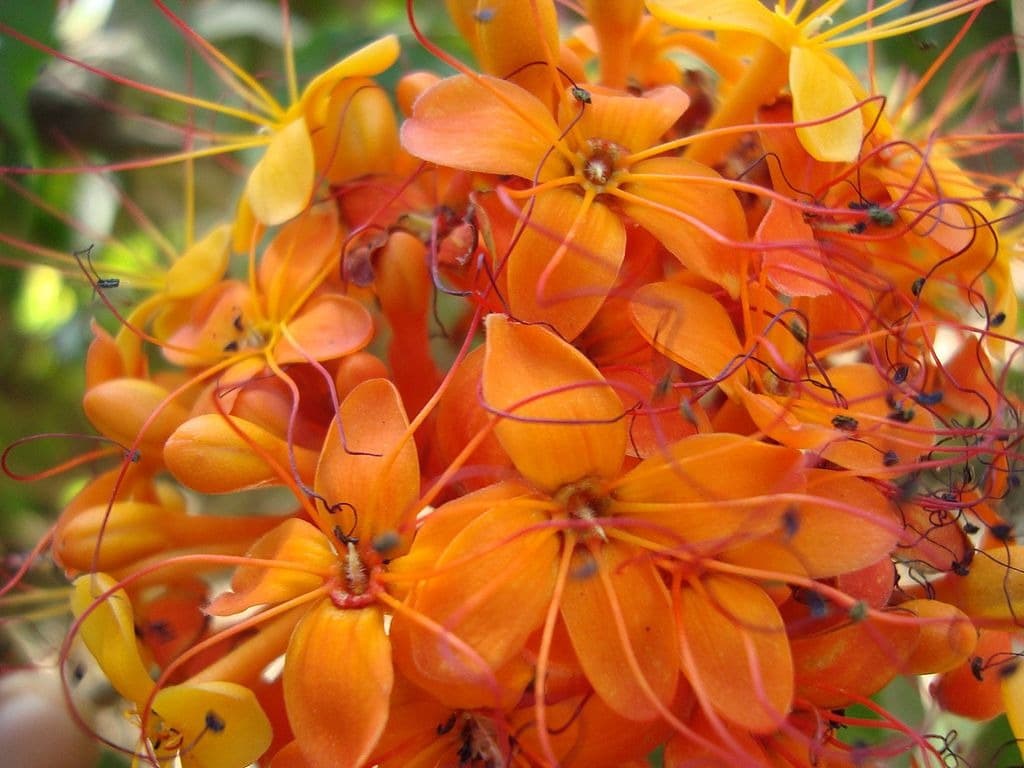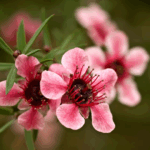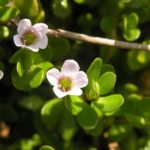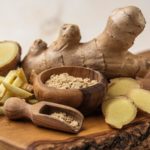
Menna Williams
BHSc (Nat), AdvDip Ayurveda, GradDipMedAcu
Tradition holds that when someone drinks the water in which Ashoka flowers have been rinsed, they can attain an inner state of profound peace and joy.
Today, studies show that Ashoka preparations can assist with
- Menorrhagia
- Dysmenorrhea
- Depression (especially in women)
- Uterine fibroids
- Hormone regulation
- Excessive uterine bleeding
and several other conditions.
If you are interested to learn if Ashoka is a herb that you should potentially use, we suggest reading the rest of the article.
Introduction
Ashoka is one of my favourite Ayurvedic herbs as it has such a rich history entwined with mythology and tradition. Ashoka is a Sanskrit word meaning “without sorrow” or “which that gives no grief”.
Traditionally it is believed that if someone drinks the water in which Ashoka flowers have steeped they can attain an inner state of profound peace and joy, healing the suffering and sorrow caused by mourning, pain, burdens, trauma, disappointment and loneliness.
Ashoka is considered sacred to the Hindu God of love, Kamadeva, for whom it is worshipped every year on the 27th December. It is also believed that Gautama Siddhartha, the Indian Philosopher and founder of Buddhism, was born under the branches of this tree.
Ashoka tree is seen as a guardian of female chastity
In certain parts of India, childless women may perform rituals and prayers near or around Ashoka trees, seeking blessings for fertility.
This tree is often referred to as a companion of women and is used extensively throughout India and elsewhere to treat numerous gynecological problems.
Other names
Ashoka belongs to Fabaceae sub family Caesalpiniaceae. It is often confused with Polyalthia longifolia, referred to as false Ashoka.

Botanical name: Saraca asoca.
Ancient name: Asoka/Ashoka.
Other names : Asoka tree, sorrowless tree, sita ashok, buddha tree, indian fir tree.
Characteristics
Native to India, Myanmar and Sri Lanka, Ashoka is an evergreen tree, reaching a maximum height of 9 metres, and it thrives as part of the rainforest up to 750m.
The branches of the tree are glabrous and drooping, and the leaves are 30-60 cm in length. The flowers are a bright orange/yellow and grow densely on the tree with a lovely fragrance. They change their colours to red before dying off.
The bark is dark brown to grey in colour and is carefully collected from the tree by making longitudinal and transverse incisions.
Due to its high medicinal value, Ashoka tree is being overharvested, resulting in severe reduction in natural populations of this species.[1]
Use
Traditional use
Ayurvedic scriptures and journals have mentioned Ashoka time and again for various indications which include:
- Anulomana (improves breathing)
- Vamana (prevents nausea and vomiting)
- Deepana (enhances stomach fire agni)
- Pachana (helps in digestion)
- Rochana (stimulates appetite)
- Sonisthapana (treats bleeding)
- Chakushya (treats eye problems)
- Garbhaprada (treats infertility)
- Vamanopaga (treats emesis)
- Mehahara (treats urinary tract disorders)
- Varnya (improves complexion)
- Amahara (treats indigestion)
- Dahahara (relieves burning sensation)
- Prameha (manages diabetes)
- Trutahara (relieves excessive thirst)
- Hikkanigrahana (controls hiccups)
- Hridaya (treats heart problems)
- Rasayani (rejuvenates the whole body)
- Kantya (relieves sore throat)
- Vayasthapana (prevents ageing)
- Jvara (useful in fever)
- Kasahara (Relieves cough)
- Balya (improves muscle strength)
- Gulmajit (useful in abdominal tumours)
- Pandu (treats anaemia)
- Sangrahini (treats diarrhoea)
- Kustha (treats skin disorders)
- Kanthya (improves voice)
- Arsha (treats piles)
- Krichra (treats painful micturition)
- Pushtida (gives nutrition)
Ayurvedic Energetics
In Ayurveda the energetics of herbs are an important part of their effect on the body.
Rasa (taste): Bitter, astringent.
Bitter taste is considered drying, cooling and light and can create space by draining excess fluids. Astringent is also drying and reduces excess dampness.
Virya (action): Cold refers to temperature and Ashoka being cooling is good for hot and/or inflammatory conditions.
Vipaka (post-digestive effect): Katu/Pungent
This refers to the action after the herb has been digested. Katu is also drying.
Guna (quality): Light, Rough.
This quality is a light action on the body and will decrease Kapha and improve alertness. Rough reduces Kapha and Pitta.
Dhatu (tissue): Blood, Plasma, Reproductive.
Our tissues are targeted with Ayurvedic treatments and Ashoka will work predominantly on reproductive tissue, blood and plasma.
Srota (channel): Blood, Plasma, Reproductive.
Reduces Kapha and Pitta and can balance Vata.
In Ayurveda disorders of the women’s menstrual cycles, an Ayurvedic practitioner will assess the issues on the basis of a person’s constitution (prakriti).
Vata women
The menstrual cycle is accompanied with pain due to constriction of blood vessels caused by excess Vata resulting in Sheeta (coldness) and Khara (roughness) properties.
This obstructs the free flow of Vata, and hence, painful menstruation.
RELATED — Vata imbalance: Are you always worried, anxious and cold?
Pitta women
The menstrual cycle comprises of heavy bleeding associated with swollen breasts.
RELATED — Pitta imbalance: Are you easily irritated and prone to skin rashes or heartburn?
Kapha women
The menstrual flow is heavy, with clots in the menstrual blood.
Medicinal Use
Ashoka has been used in Ayurvedic medicine for many conditions such as
- Menorrhagia
- Dysmenorrhea
- Depression (especially in women)
- Uterine fibroids
- Hormone regulation
- Excessive uterine bleeding
- Diuretic
- Decreases swelling
- Bleeding hemorrhoids
- Blood disorders
- Antifungal and antibacterial properties
The bark, seeds and flowers and the fruits of Ashoka are used for medicinal purposes.[2]
Health benefits
Polycystic Ovary Syndrome (PCOS) and Ashoka
PCOS is a complex endocrine disorder that many women experience and seek treatment during their reproductive years.
Research indicated that ethanolic extract of Ashoka, can have therapeutic implications in alleviating PCOS symptoms by
- targeting body weight gain
- hormonal profile
- liver functioning
- antioxidant activity of enzymes
Weight gain
A study focused on PCOS in female rats, split the rodents into 2 groups (control and PCOS group), and treated them with Letrozole, a medication used for women with estrogen related cancers.
PCOS group was then later on divided into 5 additional groups, disease control, metformin, and Ashoka EESA (200, 400, and 600 mg/kg, and were given treatment for 5 weeks.
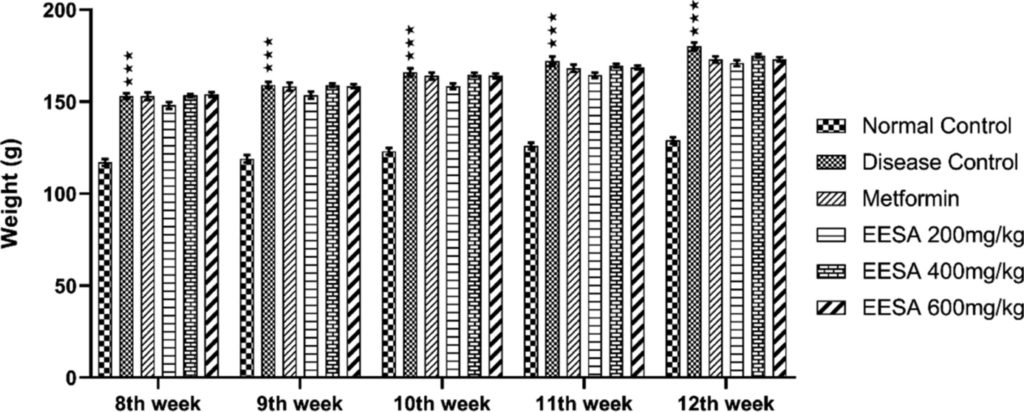
in PCOS rat model induced by letrozole.
There was a 12-15% weight decrease in the Ashoka groups than normal and disease control groups.[3]
Menorrhagia and Ashoka
Menorrhagia refers to heavy menstrual bleeding and is related to endometriosis, including pelvic inflammatory disease.
Since Ashoka bark is frequently used for premenstrual syndrome, the researchers were interested if it can also be used for assisting women who suffer from menorrhagia.
A study done on women used the premenstrual symptom scale to assess the level of discomfort and the severity of symptoms psychological, physiological and behavioural.

Ashoka is an excellent source of phytoestrogens
Phytoestrogens exhibit oestrogen mimicking action and low levels of oestrogen is a cofactor in PMS and also with post menopausal symptoms.[4]
RELATED — Menopause: Guide to Signs and Symptoms
Antimicrobial and antifungal properties of Ashoka
Four different extracts of Ashoka were tested for antibacterial activity against a number of bacteria including
- Salmonella
- E-Coli
- Staphylococcus aureus
- Bacillus
Bark extracts of Saraca Asoka were investigated for in vitro antibacterial activity against Staphylococcus aureus, Escherichia coli, Pseudomonas aeruginosa, Proteus vulgaris, Bacillus aureus and Klebsiella pneumoniae at 4 mg/ml using agar well diffusion method.
The ethanol and distilled water extracts showed significant broad spectrum antibacterial activity.[5]
Anti-Cancer Properties of Ashoka
As the bark of the Yew tree gave us Paclitaxel sold under the brand name Taxol is a chemotherapy medication used to treat cancer.
The bark of the Ashoka tree has also garnered much interest for its anti-cancer properties.
A 2017 study aimed to analyse chemo preventive effects of the flavonoids found in the Ashoka bark and their effect on acute myeloid leukaemia (AML) on mice.
The findings of this research suggested that catechin (phytochemicals) from the bark of Ashoka has chemoprotective activity.[6]
Neurological health and Ashoka
In a study on mice looking at acute restraint stress, the subjects were given Ashoka flower extract repeatedly over 7 days.
The group receiving Ashoka flowers showed reduced levels of stress, and an increase in glutathione peroxidase, which is an antioxidant enzyme class with the capacity to scavenge free radicals.[7]
Therapeutic dosage
Recommended dosage will vary according to the condition being treated with Ashoka and the age of the person taking it.
Ashoka can be taken in many forms, such as powder, tablet, juice, decoction, capsule or being made into a paste.
Ashoka bark powder should be taken up to a half teaspoon a day mixed with honey or water, and it should be taken after meals. This is to avoid nausea and abdominal discomfort.
Tablets: 1-2 a day taken after meals.
For dysmenorrhea, Ashoka should be taken on Day 14 of cycle for two weeks, and for up to 3 months initially.
Safety concerns
There is no evidence that Ashoka should be avoided by any particular individuals. However, it is always advisable for pregnant, breastfeeding women and individuals with chronic illnesses to consult a professional prior to taking Ashoka.
Also, the safety of Ashoka for children is not well studied and is generally therefore unsuitable.
As with any medicine, it is good to be aware of any allergic reactions, especially if you have allergies to plants from the fabacea (legume) family which includes Ashoka.
Possible interactions with medications
Ashoka may have estrogenic effects, so it could potentially interact with hormone replacement therapies or medications that affect hormone levels.
There is a theoretical risk that Ashoka might enhance the effects of anticoagulant medications, increasing the risk of bleeding. If you are taking blood thinners like warfarin or aspirin, discuss the use of Saraca asoca with your healthcare provider.
If you are diabetic and taking medications to control blood sugar, using Ashoka alongside these medications may require monitoring and adjustment of dosage.
Possible interactions with herbs and supplements
Currently, ashoka seems safe to be taken with other herbs and supplements.
Summary

Note — feel free to share or download this illustration.
Related Questions
1. Are there any side-effects with taking Ashoka?
Some people may experience digestive disturbances in the initial stages, so lowering the initial dosage amount will be beneficial in this instance.
2. For how long can I take Ashoka?
There is no evidence to indicate that taking Ashoka long term is a concern.
3. Can Ashoka lower the testosterone levels, or increase the levels of oestrogen in men?
Ashoka contains phytoestrogens, but their impact on estrogen levels in men is not well-established through rigorous scientific research.
Estrogen is primarily a female hormone, though men also produce it in smaller amounts. Phytoestrogens are compounds found in some plants that can weakly mimic estrogen in the body.
4. What are the different formulas and ways Ashoka can be prepared and found in therapeutic use?
Ashokarishta is made by fermenting Ashoka bark along with other herbs.
Ashoka Ghrita is prepared by cooking Ashoka bark with ghee. Ghrita refers to medicated ghee.
Ashoka Taila is when Ashoka bark is processed with oils to make medicated oils that can be used externally or internally. Taila refers to oil.
Combined Herbal Formulations: Ashoka is often combined with other herbs such as Lodhra (Symplocos racemosa), Shatavari (Asparagus racemosus), and Manjishta (Rubia cordifolia) to enhance its therapeutic effects on women’s health issues.
5. Can Ashoka be used externally?
Yes. An application of Ashoka paste and oil can be used for wound healing, skin disorders and skin inflammation.
6. What is Ashokarishta?
Ashokarishta is a well known Ayurvedic decoction made up of 12 other herbs, but is specifically based on Ashoka.
The decoction is fermented and is used extensively for a number of health concerns for women, such as:
- PCOS
- Menstrual disorders
- Menopausal symptoms
- Uterine health
- Postpartum recovery.
7. Where can I obtain Ashoka?
As the tree is becoming more difficult to harvest there have been some reports of the Ashoka bark being replaced with other powders/barks.
So, it is very important to authenticate and ensure you are purchasing from a quality supplier USDA certified or equivalent.
If you have any questions about Ashoka, please ask us in the comments section.
Menna has been in New Zealand for many years and enjoys supporting and working with people on their personal health journey, by drawing on ancient texts and modern science to tailor their treatments…
If you would like to learn more about Menna, see Expert: Menna Williams.
References
(1) Sumangala R. C., Shaanker R. U., Dayanandan S., Vasudeva R. and Ravikanth G. 2013 Identification of novel microsatellite markers for Saraca asoca, a medicinally important tree species in India. J. Genet. 92, e93–e95. Retrieved from https://www.researchgate.net/publication/258342607_Identification_of_novel_microsatellite_markers_for_Saraca_asoca_a_medicinally_important_tree_species_in_India
(2) Valvi, Vahil, Varghese, Digholkar, Garg, Deshpande, Malvankar, Chinmay, Pawar, Atmaram,Kumar, Dileep 2022/10/12 Saraca asoca: A scoping review on the phytoconstituents, bioactives and their therapeutic effects, JO – German Journal of Pharmaceuticals and Biomaterials
(3) Bu N, Jamil A, Hussain L, Alshammari A, Albekairi TH, Alharbi M, Jamshed A, Bazmi RR, Younas A. Phytochemical-Based Study of Ethanolic Extract of Saraca asoca in Letrozole-Induced Polycystic Ovarian Syndrome in Female Adult Rats. ACS Omega. 2023 Nov 1;8(45):42586-42597. doi: 10.1021/acsomega.3c05274. PMID: 38024692; PMCID: PMC10652831. Retrieved from https://www.ncbi.nlm.nih.gov/pmc/articles/PMC10652831/
(4) Ajayakuma, Shieymol V, Ansary PY, Sara Money Oommen. A case study on effectiveness of bhavita churna of Asoka twak in Premenstrual Syndrome International Journal of Ayurvedic Medicine April 2022. Retrieved from https://www.researchgate.net/publication/360543321_A_case_study_on_effectiveness_of_bhavita_churna_of_Asoka_twak_in_Premenstrual_Syndrome
(5) Pradhan et al, L. Joseph, V. Gupta, R. Chulet1, H. Arya, R. Verma , A. Bajpai 1 School of pharmaceutical sciences, Jaipur national university, Jaipur, Rajasthan, Saraca Asoka Ashoka: a Review. Journal of Chemical and Pharmaceutical Research, 2009, 1 (1):62-71
(6) Mukhopadhyay MK, Shaw M, Nath D. Chemopreventive Potential of Major Flavonoid Compound of Methanolic Bark Extract of Saraca asoca (Roxb.) in Benzene-induced Toxicity of Acute Myeloid Leukemia Mice. Pharmacogn Mag. 2017 Jul;13(Suppl 2):S216-S223. doi: 10.4103/pm.pm_326_15. Epub 2017 Jul 11. PMID: 28808383; PMCID: PMC5538157.
(7) Shashikumara S, Purushotham K, Darshan CL, Kalal BS. Characterization of antidepressant activity of Saraca asoca flower (Roxb.) Wilde in mice subjected to acute restraint stress. Am J Transl Res. 2022 Jul 15;14(7):5014-5023. PMID: 35958453; PMCID: PMC9360865. Retrieved from https://www.ncbi.nlm.nih.gov/pmc/articles/PMC9360865/

